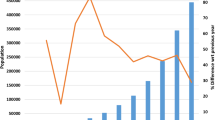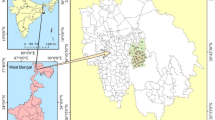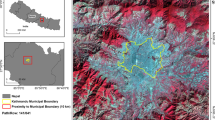Abstract
The main objective of this paper is to analyze urban sprawl in the metropolitan city of Tripoli, Libya. Logistic regression model is used in modeling urban expansion patterns, and in investigating the relationship between urban sprawl and various driving forces. The 11 factors that influence urban sprawl occurrence used in this research are the distances to main active economic centers, to a central business district, to the nearest urbanized area, to educational area, to roads, and to urbanized areas; easting and northing coordinates; slope; restricted area; and population density. These factors were extracted from various existing maps and remotely sensed data. Subsequently, logistic regression coefficient of each factor is computed in the calibration phase using data from 1984 to 2002. Additionally, data from 2002 to 2010 were used in the validation. The validation of the logistic regression model was conducted using the relative operating characteristic (ROC) method. The validation result indicated 0.86 accuracy rate. Finally, the urban sprawl probability map was generated to estimate six scenarios of urban patterns for 2020 and 2025. The results indicated that the logistic regression model is effective in explaining urban expansion driving factors, their behaviors, and urban pattern formation. The logistic regression model has limitations in temporal dynamic analysis used in urban analysis studies. Thus, an integration of the logistic regression model with estimation and allocation techniques can be used to estimate and to locate urban land demands for a deeper understanding of future urban patterns.








Similar content being viewed by others
References
Al-shalabi, M., Billa, L., Pradhan, B., Mansor, S., & Al-Sharif, A. A. A. (2012). Modelling urban growth evolution and land-use changes using GIS based cellular automata and SLEUTH models: the case of Sana’a metropolitan city, Yemen. Environmental Earth Sciences. doi:10.1007/s12665-012-2137-6.
Al-shalabi, M., Pradhan, B., Billa, L., Mansor, S., & Althuwaynee, O. F. (2013). Manifestation of remote sensing data in modeling urban sprawl using the SLEUTH model and brute force calibration: a case study of Sana’a City, Yemen. Journal of the Indian Society of Remote Sensing. doi:10.1007/s12524-012-0215-6.
Angotti, T. (1993). Metropolis 2000: Planning, poverty and politics. London: Routledge.
Bui, D. T., Lofman, O., Revhaug, I., & Dick, O. (2011). Landslide susceptibility analysis in the Hoa Binh province of Vietnam using statistical index and logistic regression. Natural Hazards, 59, 1413–1444.
Campbell, C. E., Allen, J., & Lu, K. S. (2007). Modeling growth and predicting future developed land in the upstate of South Carolina. Report submitted to the Saluda-Reedy Watershed Consortium. Strom Thurmond Institute, Clemson University, Clemson, South Carolina.
Cheng, J., Ottens, H., Masser, I., & Turkstra, J. (2003). Understanding urban growth: a conceptual model. International Journal of Urban Sciences, 7, 83–101.
Clarke, K. C., & Gaydos, L. J. (1998). Loose-coupling a cellular automaton model and GIS: long-term urban growth prediction for San Francisco and Washington/Baltimore. International Journal of Geographical Information Science, 12, 699–714.
Devkota, K. C., Regmi, A. D., Pourghasemi, H. R., Yoshida, K., Pradhan, B., Ryu, I. C., Dhital, M. R., & Althuwaynee, O. F. (2013). Landslide susceptibility mapping using certainty factor, index of entropy and logistic regression models and their comparison at a landslide prone area in Nepal Himalaya. Natural Hazards, 65(1), 135–165. doi:10.1007/s11069-012-0347-6.
Dietzel, C., & Clarke, K. (2006). The effect of disaggregating land use categories in cellular automata during model calibration and forecasting. Computers, Environment and Urban Systems, 30, 78–101.
Eyoh, A., Olayinka, D. N., Nwilo, P., Okwuashi, O., Isong, M., & Udoudo, D. (2012). Modelling and predicting future urban expansion of lagos, nigeria from remote sensing data using logistic regression and GIS. International Journal of Applied Science and Technology, 2, 116–124.
Firman, T. (1997). Land conversion and urban development in the northern region of West Java, Indonesia. Urban Studies, 34, 1027–1046.
Gillham, O. (2002). The limitless city: A primer on the urban sprawl debate (pp. 328). Washington, DC, USA: Island Press.
Helbich, M., & Leitner, M. (2010). Postsuburban spatial evolution of Vienna's urban fringe: evidence from point process modeling. Urban Geography, 31, 1100–1117.
Hu, Z., & Lo, C. P. (2007). Modeling urban growth in Atlanta using logistic regression. Computers, Environment and Urban Systems, 31, 667–688.
Huang, B., Zhang, L., & Wu, B. (2009). Spatiotemporal analysis of rural–urban land conversion. International Journal of Geographical Information Science, 23, 379–398.
Irwin, E. G., & Geoghegan, J. (2001). Theory, data, methods: developing spatially explicit economic models of land use change. Agriculture, Ecosystems & Environment, 85, 7–24.
Jat, M. K., Garg, P. K., & Khare, D. (2008). Monitoring and modelling of urban sprawl using remote sensing and GIS techniques. International Journal of Applied Earth Observation and Geoinformation, 10, 26–43.
Jiang, B., & Yao, X. (2010). Geospatial analysis and modelling of urban structure and dynamics (Vol. 99, p. 440). Springer: Netherlands.
Jokar Arsanjani, J. (2011). Dynamic land use/cover change modelling: Geosimulation and multiagent-based modelling (hardback)(series: springer theses) (XVII, p. 139), Springer: Berlin Heidelberg.
Jokar Arsanjani, J., Helbich, M., Kainz, W., & Darvishi Boloorani, A. (2013). Integration of logistic regression, Markov chain and cellular automata models to simulate urban expansion. International Journal of Applied Earth Observation and Geoinformation, 21, 265–275.
Kleinbaum, D. G., & Klein, M. (2010). Logistic regression: A self-learning text. New York: Springer.
Knox, P. L. (1993). The restless urban landscape. Englewood Cliffs: Prentice Hall.
Lambin, E. F., & Geist, H. J. (2006). Land-use and land-cover change: Local processes and global impacts. Berlin Heidelberg: Springer.
Lambin, E. F., Turner, B. L., Geist, H. J., Agbola, S. B., Angelsen, A., Bruce, J. W., et al. (2001). The causes of land-use and land-cover change: moving beyond the myths. Global Environmental Change, 11, 261–269.
Lin, Y.-P., Chu, H.-J., Wu, C.-F., & Verburg, P. H. (2010). Predictive ability of logistic regression, auto-logistic regression and neural network models in empirical land-use change modeling – a case study. International Journal of Geographical Information Science, 25, 65–87.
López, E., Bocco, G., Mendoza, M., & Duhau, E. (2001). Predicting land-cover and land-use change in the urban fringe: a case in Morelia city, Mexico. Landscape and Urban Planning, 55, 271–285.
Mahiny, A. S., & Turner, B. J. (2003). Modeling past vegetation change through remote sensing and GIS: a comparison of neural networks and logistic regression methods. In Proceedings of the 7th international conference on geocomputation. University of Southampton, UK.
Masser, I. (2001). Managing our urban future: the role of remote sensing and geographic information systems. Habitat International, 25, 503–512.
Menard, S. (2004). Six approaches to calculating standardized logistic regression coefficients. The American Statistician, 58, 218–223.
Overmars, K. P., & Verburg, P. H. (2005). Analysis of land use drivers at the watershed and household level: linking two paradigms at the Philippine forest fringe. International Journal of Geographical Information Science, 19, 125–152.
Peng, C.-Y. J., Lee, K. L., & Ingersoll, G. M. (2002). An introduction to logistic regression analysis and reporting. The Journal of Educational Research, 96, 3–14.
Poelmans, L., & Van Rompaey, A. (2010). Complexity and performance of urban expansion models. Computers, Environment and Urban Systems, 34, 17–27.
Pontius, R. G., Jr., & Schneider, L. C. (2001). Land-cover change model validation by an ROC method for the Ipswich watershed, Massachusetts, USA. Agriculture, Ecosystems & Environment, 85, 239–248.
Pradhan, B. (2011). Manifestation of an advanced fuzzy logic model coupled with Geo-information techniques to landslide susceptibility mapping and their comparison with logistic regression modelling. Environmental and Ecological Statistics, 18(3), 471–493. doi:10.1007/s10651-010-0147-7.
Pradhan, B. (2010a). Remote sensing and GIS-based landslide hazard analysis and cross-validation using multivariate logistic regression model on three test areas in Malaysia. Advances in Space Research, 45(10), 1244–1256. doi:10.1016/j.asr.2010.01.006.
Pradhan, B. (2010b). Landslide susceptibility mapping of a catchment area using frequency ratio, fuzzy logic and multivariate logistic regression approaches. Journal of the Indian Society of Remote Sensing, 38(2), 301–320. doi:10.1007/s12524-010-0020-z.
Pradhan, B. (2009). Flood susceptible mapping and risk area estimation using logistic regression, GIS and remote sensing. Journal of Spatial Hydrology, 9(2), 1–18.
Serneels, S., & Lambin, E. F. (2001). Proximate causes of land-use change in Narok District, Kenya: a spatial statistical model. Agriculture, Ecosystems & Environment, 85, 65–81.
Sudhira, H. S., Ramachandra, T. V., & Jagadish, K. S. (2004). Urban sprawl: metrics, dynamics and modelling using GIS. International Journal of Applied Earth Observation and Geoinformation, 5, 29–39.
Sweet, S. A., & Grace-Martin, K. (1999). Data analysis with SPSS (Vol. 1, p. 204): Allyn & Bacon.
Tv, R., Aithal, B. H., & Sanna, D. D. (2012). Insights to urban dynamics through landscape spatial pattern analysis. International Journal of Applied Earth Observation and Geoinformation, 18, 329–343.
Veldkamp, A., & Lambin, E. F. (2001). Predicting land-use change. Agriculture, Ecosystems & Environment, 85, 1–6.
Verburg, P., & Overmars, K. (2007). Dynamic simulation of land-use change trajectories with the clue–s model. Modelling Land-Use Change, 321–335.
Verburg, P. H., Kok, K., Pontius, R. G., & Veldkamp, A. (2006). Modeling land-use and land-cover change. Land-Use and Land-Cover Change, 117–135.
Wang, J., & Mountrakis, G. (2011). Developing a multi-network urbanization model: a case study of urban growth in Denver, Colorado. International Journal of Geographical Information Science, 25, 229–253.
Yang, X., & Lo, C. (2003). Modelling urban growth and landscape changes in the Atlanta metropolitan area. International Journal of Geographical Information Science, 17, 463–488.
Youssef, A. M., Pradhan, B., & Tarabees, E. (2011). Integrated evaluation of urban development suitability based on remote sensing and GIS techniques: contribution from the analytic hierarchy. Arabian Journal of Geosciences, 4(3–4). doi:10.1007/s12517-009-0118-1.
Zhao, Y., & Murayama, Y. (2011). Urban dynamics analysis using spatial metrics geosimulation. Spatial Analysis and Modeling in Geographical Transformation Process, 153–167.
Acknowledgments
The first author greatly acknowledges Libyan government for providing data and financial support for this work.
Author information
Authors and Affiliations
Corresponding author
About this article
Cite this article
Alsharif, A.A.A., Pradhan, B. Urban Sprawl Analysis of Tripoli Metropolitan City (Libya) Using Remote Sensing Data and Multivariate Logistic Regression Model. J Indian Soc Remote Sens 42, 149–163 (2014). https://doi.org/10.1007/s12524-013-0299-7
Received:
Accepted:
Published:
Issue Date:
DOI: https://doi.org/10.1007/s12524-013-0299-7




